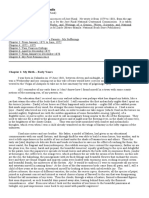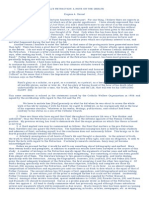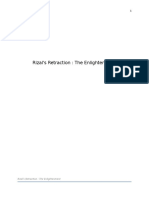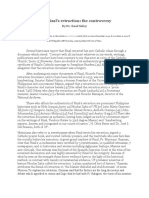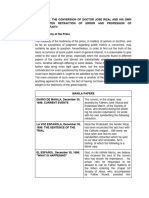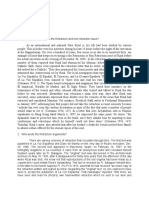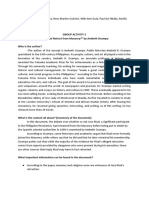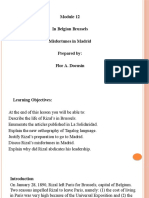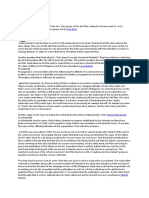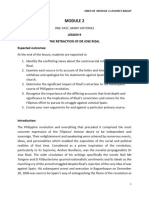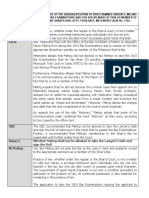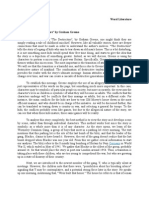Retraction of Rizal
Uploaded by
kyyclassesRetraction of Rizal
Uploaded by
kyyclassesRetraction of Rizal
By Fr. Vicente Balaguer and Rafael Palma
Fr. Vicente Balaguer was born in Alicante, Spain, on January 19, 1851. He joined the Society of Jesus on
July 30, 1890 and went to the Philippines in 1894. Moreover, he was one of the Jesuit priests who visited
Rizal’s last hours in Fort Santiago and claimed that he managed to persuade Rizal to denounce masonry
and return to the Catholic fold. In 1917 when he had returned to Spain, an affidavit executed that
proves he was who solemnized the marriage of Jose Rizal and Josephine Bracken. Rafael Palma was born
on October 24, 1874. He was a Filipino politician, lawyer, writer, educator and a famous freemason.
Additionally, he became the fourth President of the University of the Philippines. He was later elected as
senator under the Nacionalista Party, consistently representing the 4th District, in both the 1916 and
1919 senatorial polls. Furthermore, he was the author of Biografia de Rizal, a work on the life of the
national hero which won a literary contest in 1938 sponsored by the Commonwealth Government. The
story of Rizal’s alleged retraction is found in chapter 32 and 33 with his analysis in the latter chapter. Dr.
Jose Rizal was arrested, tried, and sentenced to death by a Spanish court martial after being implicated
as a leader of the Philippine Revolution. On December 30, 1896, accounts exist that Rizal allegedly
retracted his masonic ideals and his writings reconverted to Catholicism following several hours of
persuasion by the Jesuit priests. A few hours before he was shot, Rizal signed a document stating that he
was a Catholic and retracted all his writings against the church and the document were as “The
Retraction”. Moreover, Rizal’s retraction letter was discovered by Father Manuel Garcia, C.M. in 1935 at
the Catholic hierarchy’s archive in Manila. The letter, dated December 29, 1896. According to Fr.
Balaguer, he and Fr. Vilaclara arrived in Rizal’s prison cell around 10o’clock in the morning on December
29, 1896. He mentioned in his letter and affidavit that their encounter with Rizal started with a
discussion of some articles of Catholic faith. They debated on issues such as the supremacy of faith over
reason and the dogmatic differences that divided Catholics and Protestants. They explained to him that
they could not administer the sacrament she needed without him signing a retraction letter and making
a profession of faith. The two Jesuits left Rizal’s prison around lunchtime, with Rizal still undecided over
whether to sign the retraction letter or not. The Jesuits went straight to the archbishop’s palace and
informed their superiors of what had transpired during their first meeting with Rizal. Frs. Balaguer and
Vilaclara returned to Rizal around 3 o’clock in the afternoon and tried until sunset to persuade him to
recant. They were still not able to convince him to sign the retraction document. Their third meeting
with Rizal took place at 10 o’clock that night, and it was during this meeting that they showed Rizal the
two retraction templates Fr. Pi had given them. According to Fr. Balaguer, Rizal found the first template
unacceptable because it was too long and its language and style were not reflective of his personality. So
Fr. Balaguer withdrew it and offered the shorter one. Rizal did not sign it right away because he was
uncomfortable with the statement “I abominate Masonry as a society reprobated by the Church.” Rizal
wanted to emphasize that Philippine Masonry was not hostile to Catholicism and that Masonry in
London did not require its members to renounce their faith. The Jesuits allowed Rizal to revise the
retraction template, and his final version read, “I abominate Masonry as the enemy of the Church and
reprobated by the same Church” (Cavanna 1956, 9). After making other minor changes to the draft, Rizal
together with Señor Fresno, chief of the picket, and Señor Moure, adjutant of the plaza signed the
retraction letter before midnight. After which, Fr. Balaguer handed it over to Fr. Pi, who in turn submitted
it to Archbishop Bernardino Nozaleda. On the other hand, Rafael Palma, a prominent Mason,
disputed the veracity of the document of the alleged retraction because it did not reflect Rizal’s true
character and beliefs. He regarded the resurrected retraction story as a “pious fraud”. Where, according
to his analysis, the retraction of Rizal was hearsay with the following reasons: First, the documents of
retraction were kept secret so that no one except the authorities was able to see it that time. Secondly,
when the family of Rizal ask for the original copy of the document as well as the certificate
of canonical marriage with Josephine Bracken, bot petitions were denied. Third, Rizal’s burial was kept
secret, in spite of what Rizal meant to the Filipinos and of what his conversion meant, no masses were
said for his soul or funeral held by Catholics. Notwithstanding that Rizal was reconciled with the
church, he was not buried in the Catholic cemetery of Paco but in the ground, without any cross or stone
to mark his grave. And, in the entry of the entry in the book of burials of the interment of Rizal’s body is
not made on the page those buried on December 30, 1896, instead he was considered among persons
died impenitent with no spiritual aid. Lastly, there was no moral motive for the conversion. To conclude,
whether or not Jose Rizal retracted, the researchers believe that the retraction document
was more of Rizal taking a moral courage to recognize his mistakes. Perhaps it may be true
that he retracted and reverted to his faith, but this does not diminish Rizal’s stature as a great hero with
such greatness. As mentioned, the documentary entitled “Ang Bayaning Third World”, Joel Torre’s
impersonation of Rizal told the time travellers that whether he retracted or not, it does change what he
has already done and what his writings have already achieved. Furthermore, former Senator Jose Diokno
once stated, "Surely whether Rizal died as a Catholic or an apostate adds or detracts nothing from his
greatness as a Filipino. Catholic or Mason, Rizal is still Rizal - the hero who courted death "to
prove to those who deny our patriotism that we know how to die for our duty and our beliefs".
Analysis Rizal's Retraction
At least four texts of Rizal’s retraction have surfaced. The fourth text appeared in El Imparcial on the day after Rizal’s
execution; it is the short formula of the retraction.
The first text was published in La Voz Española and Diaro de Manila on the very day of Rizal’s execution, Dec. 30, 1896.
The second text appeared in Barcelona, Spain, on February 14, 1897, in the fortnightly magazine in La Juventud; it came
from an anonymous writer who revealed himself fourteen years later as Fr. Balaguer. The "original" text was discovered in
the archdiocesan archives on May 18, 1935, after it disappeared for thirty-nine years from the afternoon of the day when
Rizal was shot.
We know not that reproductions of the lost original had been made by a copyist who could imitate Rizal’s handwriting. This
fact is revealed by Fr. Balaguer himself who, in his letter to his former superior Fr. Pio Pi in 1910, said that he had received
"an exact copy of the retraction written and signed by Rizal. The handwriting of this copy I don’t know nor do I remember
whose it is. . ." He proceeded: "I even suspect that it might have been written by Rizal himself. I am sending it to you that
you may . . . verify whether it might be of Rizal himself . . . ." Fr. Pi was not able to verify it in his sworn statement.
This "exact" copy had been received by Fr. Balaguer in the evening immediately preceding Rizal’s execution, Rizal y su
Obra, and was followed by Sr. W. Retana in his biography of Rizal, Vida y Escritos del Jose Rizal with the addition of the
names of the witnesses taken from the texts of the retraction in the Manila newspapers. Fr. Pi’s copy of Rizal’s retraction
has the same text as that of Fr. Balaguer’s "exact" copy but follows the paragraphing of the texts of Rizal’s retraction in
the Manila newspapers.
Regarding the "original" text, no one claimed to have seen it, except the publishers of La Voz Espanola. That newspaper
reported: "Still more; we have seen and read his (Rizal’s) own hand-written retraction which he sent to our dear and
venerable Archbishop…" On the other hand, Manila pharmacist F. Stahl wrote in a letter: "besides, nobody has seen this
written declaration, in spite of the fact that quite a number of people would want to see it. "For example, not only Rizal’s
family but also the correspondents in Manila of the newspapers in Madrid, Don Manuel Alhama of El Imparcial and Sr.
Santiago Mataix of El Heraldo, were not able to see the hand-written retraction.
Neither Fr. Pi nor His Grace the Archbishop ascertained whether Rizal himself was the one who wrote and signed the
retraction. (Ascertaining the document was necessary because it was possible for one who could imitate Rizal’s handwriting
aforesaid holograph; and keeping a copy of the same for our archives, I myself delivered it personally that the same
morning to His Grace Archbishop… His Grace testified: At once the undersigned entrusted this holograph to Rev. Thomas
Gonzales Feijoo, secretary of the Chancery." After that, the documents could not be seen by those who wanted to examine
it and was finally considered lost after efforts to look for it proved futile.
On May 18, 1935, the lost "original" document of Rizal’s retraction was discovered by the archdeocean archivist Fr. Manuel
Garcia, C.M. The discovery, instead of ending doubts about Rizal’s retraction, has in fact encouraged it because the newly
discovered text retraction differs significantly from the text found in the Jesuits’ and the Archbishop’s copies. And, the fact
that the texts of the retraction which appeared in the Manila newspapers could be shown to be the exact copies of the
"original" but only imitations of it. This means that the friars who controlled the press in Manila (for example, La Voz
Española) had the "original" while the Jesuits had only the imitations.
We now proceed to show the significant differences between the "original" and the Manila newspapers texts of the
retraction on the one hand and the text s of the copies of Fr. Balaguer and F5r. Pio Pi on the other hand.
First, instead of the words "mi cualidad" (with "u") which appear in the original and the newspaper texts, the Jesuits’
copies have "mi calidad" (with "u").
Second, the Jesuits’ copies of the retraction omit the word "Catolica" after the first "Iglesias" which are found in the
original and the newspaper texts.
Third, the Jesuits’ copies of the retraction add before the third "Iglesias" the word "misma" which is not found in the
original and the newspaper texts of the retraction.
Fourth, with regards to paragraphing which immediately strikes the eye of the critical reader, Fr. Balaguer’s text does not
begin the second paragraph until the fifth sentences while the original and the newspaper copies start the second
paragraph immediately with the second sentences.
Fifth, whereas the texts of the retraction in the original and in the manila newspapers have only four commas, the text of
Fr. Balaguer’s copy has eleven commas.
Sixth, the most important of all, Fr. Balaguer’s copy did not have the names of the witnesses from the texts of the
newspapers in Manila.
In his notarized testimony twenty years later, Fr. Balaguer finally named the witnesses. He said "This . . .retraction was
signed together with Dr. Rizal by Señor Fresno, Chief of the Picket, and Señor Moure, Adjutant of the Plaza." However, the
proceeding quotation only proves itself to be an addition to the original. Moreover, in his letter to Fr. Pi in 1910, Fr.
Balaguer said that he had the "exact" copy of the retraction, which was signed by Rizal, but her made no mention of the
witnesses. In his accounts too, no witnesses signed the retraction.
How did Fr. Balaguer obtain his copy of Rizal’s retraction? Fr. Balaguer never alluded to having himself made a copy of the
retraction although he claimed that the Archbishop prepared a long formula of the retraction and Fr. Pi a short formula. In
Fr. Balaguer’s earliest account, it is not yet clear whether Fr. Balaguer was using the long formula of nor no formula in
dictating to Rizal what to write. According to Fr. Pi, in his own account of Rizal’s conversion in 1909, Fr. Balaguer dictated
from Fr. Pi’s short formula previously approved by the Archbishop. In his letter to Fr. Pi in 1910, Fr. Balaguer admitted that
he dictated to Rizal the short formula prepared by Fr. Pi; however; he contradicts himself when he revealed that the
"exact" copy came from the Archbishop. The only copy, which Fr. Balaguer wrote, is the one that appeared ion his earliest
account of Rizal’s retraction.
Where did Fr. Balaguer’s "exact" copy come from? We do not need long arguments to answer this question, because Fr.
Balaguer himself has unwittingly answered this question. He said in his letter to Fr. Pi in 1910:
"…I preserved in my keeping and am sending to you the original texts of the two formulas of retraction, which they (You)
gave me; that from you and that of the Archbishop, and the first with the changes which they (that is, you) made; and the
other the exact copy of the retraction written and signed by Rizal. The handwriting of this copy I don’t know nor do I
remember whose it is, and I even suspect that it might have been written by Rizal himself."
In his own word quoted above, Fr. Balaguer said that he received two original texts of the retraction. The first, which came
from Fr. Pi, contained "the changes which You (Fr. Pi) made"; the other, which is "that of the Archbishop" was "the exact
copy of the retraction written and signed by Rizal" (underscoring supplied). Fr. Balaguer said that the "exact copy" was
"written and signed by Rizal" but he did not say "written and signed by Rizal and himself" (the absence of the reflexive
pronoun "himself" could mean that another person-the copyist-did not). He only "suspected" that "Rizal himself" much as
Fr. Balaguer did "not know nor ... remember" whose handwriting it was.
Thus, according to Fr. Balaguer, the "exact copy" came from the Archbishop! He called it "exact" because, not having seen
the original himself, he was made to believe that it was the one that faithfully reproduced the original in comparison to
that of Fr. Pi in which "changes" (that is, where deviated from the "exact" copy) had been made. Actually, the difference
between that of the Archbishop (the "exact" copy) and that of Fr. Pi (with "changes") is that the latter was "shorter" be
cause it omitted certain phrases found in the former so that, as Fr. Pi had fervently hoped, Rizal would sign it.
According to Fr. Pi, Rizal rejected the long formula so that Fr. Balaguer had to dictate from the short formula of Fr. Pi.
Allegedly, Rizal wrote down what was dictated to him but he insisted on adding the phrases "in which I was born and
educated" and "[Masonary]" as the enemy that is of the Church" – the first of which Rizal would have regarded as
unnecessary and the second as downright contrary to his spirit. However, what actually would have happened, if we are to
believe the fictitious account, was that Rizal’s addition of the phrases was the retoration of the phrases found in the
original which had been omitted in Fr. Pi’s short formula.
The "exact" copy was shown to the military men guarding in Fort Santiago to convince them that Rizal had retracted.
Someone read it aloud in the hearing of Capt. Dominguez, who claimed in his "Notes’ that Rizal read aloud his retraction.
However, his copy of the retraction proved him wrong because its text (with "u") and omits the word "Catolica" as in Fr.
Balaguer’s copy but which are not the case in the original. Capt. Dominguez never claimed to have seen the retraction: he
only "heard".
The truth is that, almost two years before his execution, Rizal had written a retraction in Dapitan. Very early in 1895,
Josephine Bracken came to Dapitan with her adopted father who wanted to be cured of his blindness by Dr. Rizal; their
guide was Manuela Orlac, who was agent and a mistress of a friar. Rizal fell in love with Josephine and wanted to marry
her canonically but he was required to sign a profession of faith and to write retraction, which had to be approved by the
Bishop of Cebu. "Spanish law had established civil marriage in the Philippines," Prof. Craig wrote, but the local government
had not provided any way for people to avail themselves of the right..."
In order to marry Josephine, Rizal wrote with the help of a priest a form of retraction to be approved by the Bishop of
Cebu. This incident was revealed by Fr. Antonio Obach to his friend Prof. Austin Craig who wrote down in 1912 what the
priest had told him; "The document (the retraction), inclosed with the priest’s letter, was ready for the mail when Rizal
came hurrying I to reclaim it." Rizal realized (perhaps, rather late) that he had written and given to a priest what the friars
had been trying by all means to get from him.
Neither the Archbishop nor Fr. Pi saw the original document of retraction. What they was saw a copy done by one who
could imitate Rizal’s handwriting while the original (almost eaten by termites) was kept by some friars. Both the
Archbishop and Fr. Pi acted innocently because they did not distinguish between the genuine and the imitation of Rizal’s
handwriting.
You might also like
- Departmental Confirmatory Examination 03 Dec 2022No ratings yetDepartmental Confirmatory Examination 03 Dec 20224 pages
- Speech On The Retraction of Rizal Consolidated EditedNo ratings yetSpeech On The Retraction of Rizal Consolidated Edited6 pages
- READING-5-The Great Debate The Rizal Retraction by Ricardo P. GarciaNo ratings yetREADING-5-The Great Debate The Rizal Retraction by Ricardo P. Garcia2 pages
- Ricardo P. Garcia, The Great Debate The Rizal Retraction (Pp. 9-19)No ratings yetRicardo P. Garcia, The Great Debate The Rizal Retraction (Pp. 9-19)5 pages
- Book Annotation - Dr. Rizal Beyond The GraveNo ratings yetBook Annotation - Dr. Rizal Beyond The Grave21 pages
- Debate: Retraction of Rizal: Shirly Mae P. Gumaru Bscrim-1 AlphaNo ratings yetDebate: Retraction of Rizal: Shirly Mae P. Gumaru Bscrim-1 Alpha5 pages
- Chapter I - The Conversion of Doctor Jose Rizal and His Own Handwritten Retraction of Error and Profession of Catholic FaithNo ratings yetChapter I - The Conversion of Doctor Jose Rizal and His Own Handwritten Retraction of Error and Profession of Catholic Faith5 pages
- Retraction of Rizal Retraction of Rizal: Report ConflictNo ratings yetRetraction of Rizal Retraction of Rizal: Report Conflict9 pages
- Retraksyon Ni Jose P Rizal.-1st Year CollegeNo ratings yetRetraksyon Ni Jose P Rizal.-1st Year College22 pages
- Reaction Paper: Rizal's Retraction Controversy100% (1)Reaction Paper: Rizal's Retraction Controversy2 pages
- Marcelo Hilario Del Pilar y Gatmaitan: Ilustrado (Knowledgeable) Propagandist of The Philippine War of IndependenceNo ratings yetMarcelo Hilario Del Pilar y Gatmaitan: Ilustrado (Knowledgeable) Propagandist of The Philippine War of Independence8 pages
- Ways To Proving That Rizal Did Not RetractNo ratings yetWays To Proving That Rizal Did Not Retract2 pages
- Cañeba, Case Study Did Jose Rizal Retract PDFNo ratings yetCañeba, Case Study Did Jose Rizal Retract PDF2 pages
- Module 1 Lesson 3: Content Analysis "Customs of The Tagalogs"No ratings yetModule 1 Lesson 3: Content Analysis "Customs of The Tagalogs"6 pages
- In Belgian Brussels Misfortunes in Madrid Prepared By: Flor A. DocusinNo ratings yetIn Belgian Brussels Misfortunes in Madrid Prepared By: Flor A. Docusin22 pages
- Name: - Student No.: - Section: - Date SubmittedNo ratings yetName: - Student No.: - Section: - Date Submitted5 pages
- " Retraction of Jose P. Rizal ": Taguig City University College of CriminologyNo ratings yet" Retraction of Jose P. Rizal ": Taguig City University College of Criminology4 pages
- Casting Process Advantages and LimitationsNo ratings yetCasting Process Advantages and Limitations3 pages
- Lloyds Core VP Deck 2023-No Video-with Regional Split-CopyNo ratings yetLloyds Core VP Deck 2023-No Video-with Regional Split-Copy43 pages
- MULTIPLE CHOICE. Choose The One Alternative That Best Completes The Statement or Answers The QuestionNo ratings yetMULTIPLE CHOICE. Choose The One Alternative That Best Completes The Statement or Answers The Question48 pages
- R01 Perbaikan Switch Box Kato COR3-200 Type - COR3-SW-217-10 SN.0092847 PT. BANDAR INDAH PERMATANo ratings yetR01 Perbaikan Switch Box Kato COR3-200 Type - COR3-SW-217-10 SN.0092847 PT. BANDAR INDAH PERMATA2 pages
- Title (With GR No. and Date) Ponente J. Tinga Doctrine FactsNo ratings yetTitle (With GR No. and Date) Ponente J. Tinga Doctrine Facts2 pages
- Dubai Co Global Strategies for Doing Business in the Gulf States 1st Edition Aamir Rehman - Own the complete ebook with all chapters in PDF format100% (2)Dubai Co Global Strategies for Doing Business in the Gulf States 1st Edition Aamir Rehman - Own the complete ebook with all chapters in PDF format55 pages
- How To Have Great 1 - 1 Meetings With Your ManagerNo ratings yetHow To Have Great 1 - 1 Meetings With Your Manager9 pages
- GMC Hummer EV SUV 2024 Emergency Response Guide - EnglishNo ratings yetGMC Hummer EV SUV 2024 Emergency Response Guide - English13 pages


